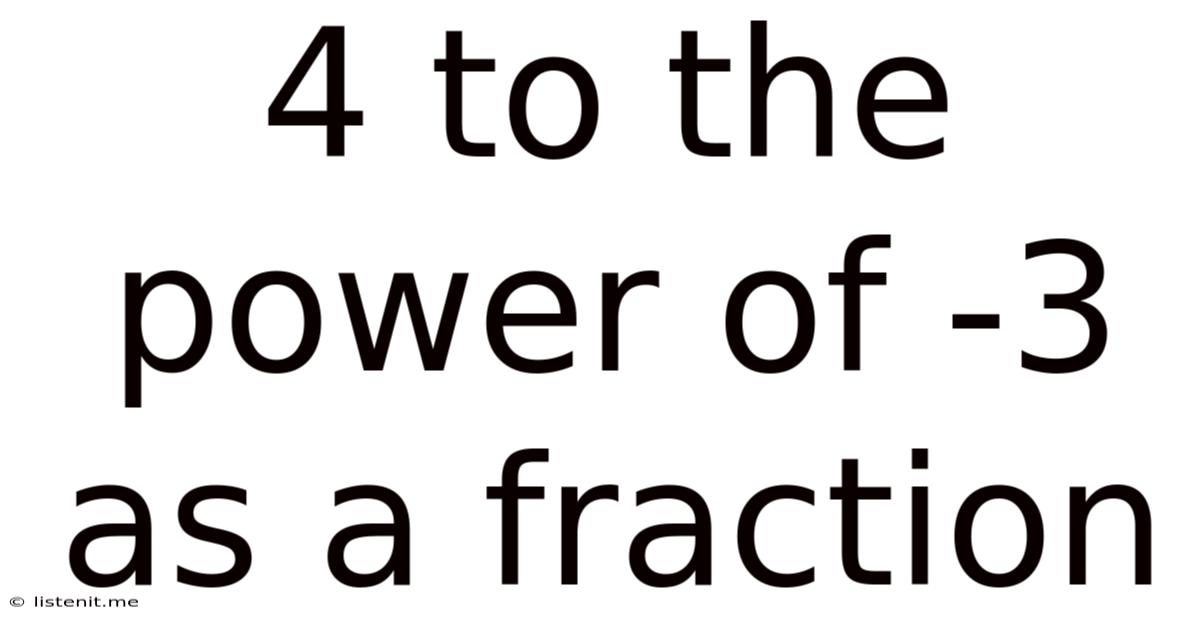4 To The Power Of -3 As A Fraction
listenit
May 25, 2025 · 5 min read

Table of Contents
4 to the Power of -3 as a Fraction: A Comprehensive Guide
Understanding exponents, especially negative ones, can be tricky. This comprehensive guide will walk you through calculating 4 to the power of -3 as a fraction, explaining the underlying principles and providing various approaches to solve similar problems. We'll cover the rules of exponents, the concept of reciprocals, and how to simplify expressions involving negative exponents. By the end, you'll not only know the answer but also possess a strong foundational understanding of these mathematical concepts.
What Does 4<sup>-3</sup> Mean?
Before diving into the calculation, let's clarify the meaning of 4<sup>-3</sup>. The exponent, -3, indicates that we're dealing with a negative power. In the world of exponents, a negative exponent signifies the reciprocal of the base raised to the positive power. In simpler terms:
a<sup>-n</sup> = 1/a<sup>n</sup>
Therefore, 4<sup>-3</sup> is equivalent to 1/4<sup>3</sup>. This means we need to calculate 4 raised to the power of 3 and then find its reciprocal (flip the fraction).
Calculating 4<sup>3</sup>
The first step is to calculate 4<sup>3</sup>, which means 4 multiplied by itself three times:
4<sup>3</sup> = 4 × 4 × 4 = 64
So, now we know that 4<sup>3</sup> equals 64.
Finding the Reciprocal: 1/4<sup>3</sup>
Now that we've calculated 4<sup>3</sup> = 64, we need to find its reciprocal. The reciprocal of a number is simply 1 divided by that number. Therefore, the reciprocal of 64 is 1/64.
Consequently:
4<sup>-3</sup> = 1/4<sup>3</sup> = 1/64
This is our final answer: 4 to the power of -3 expressed as a fraction is 1/64.
Understanding the Rules of Exponents
To solidify your understanding, let's explore the fundamental rules of exponents. These rules are crucial for solving a wide range of problems involving powers and exponents.
-
Product Rule: When multiplying terms with the same base, add the exponents: a<sup>m</sup> × a<sup>n</sup> = a<sup>m+n</sup>
-
Quotient Rule: When dividing terms with the same base, subtract the exponents: a<sup>m</sup> / a<sup>n</sup> = a<sup>m-n</sup>
-
Power Rule: When raising a power to another power, multiply the exponents: (a<sup>m</sup>)<sup>n</sup> = a<sup>mn</sup>
-
Zero Exponent Rule: Any non-zero number raised to the power of zero is 1: a<sup>0</sup> = 1
-
Negative Exponent Rule: A number raised to a negative exponent is equal to the reciprocal of the number raised to the positive exponent: a<sup>-n</sup> = 1/a<sup>n</sup>
Applying the Rules to More Complex Problems
Let's explore some more complex problems to further illustrate the application of these rules and reinforce your understanding of negative exponents.
Example 1: Simplify (2<sup>-2</sup> × 2<sup>4</sup>) / 2<sup>-1</sup>
First, apply the product rule to the numerator:
2<sup>-2</sup> × 2<sup>4</sup> = 2<sup>-2+4</sup> = 2<sup>2</sup>
Now we have:
2<sup>2</sup> / 2<sup>-1</sup>
Next, apply the quotient rule:
2<sup>2</sup> / 2<sup>-1</sup> = 2<sup>2-(-1)</sup> = 2<sup>3</sup> = 8
Therefore, (2<sup>-2</sup> × 2<sup>4</sup>) / 2<sup>-1</sup> = 8
Example 2: Simplify (3<sup>-1</sup>)<sup>2</sup> × 3<sup>3</sup>
First, apply the power rule:
(3<sup>-1</sup>)<sup>2</sup> = 3<sup>-1×2</sup> = 3<sup>-2</sup>
Now we have:
3<sup>-2</sup> × 3<sup>3</sup>
Apply the product rule:
3<sup>-2</sup> × 3<sup>3</sup> = 3<sup>-2+3</sup> = 3<sup>1</sup> = 3
Example 3: Express (1/5)<sup>-2</sup> as a whole number.
Remember that a negative exponent means taking the reciprocal. So:
(1/5)<sup>-2</sup> = (5/1)<sup>2</sup> = 5<sup>2</sup> = 25
Practical Applications of Negative Exponents
Negative exponents aren't just abstract mathematical concepts; they have practical applications in various fields, including:
-
Science: In physics and chemistry, negative exponents are used to represent extremely small quantities, such as the charge of an electron or the concentration of a substance.
-
Engineering: Negative exponents are employed in calculations involving scaling, signal processing, and decay rates.
-
Finance: Compound interest calculations often involve negative exponents to represent the present value of future payments.
-
Computer Science: Negative exponents are used in algorithms and data structures, particularly when dealing with very large or very small numbers.
Troubleshooting Common Mistakes
When working with negative exponents, some common mistakes can arise. Let's address them:
-
Incorrect application of the reciprocal: Remember that a<sup>-n</sup> = 1/a<sup>n</sup>. It's crucial to correctly apply the reciprocal to the entire base, not just parts of it.
-
Confusion with negative numbers: A negative exponent doesn't automatically make the result a negative number. The result's sign is determined by the base's sign and the exponent's magnitude.
-
Misapplication of exponent rules: Ensure you correctly apply the product, quotient, and power rules, paying close attention to the signs of the exponents.
Further Exploration: More Complex Scenarios
While we've covered the fundamentals, understanding exponents can extend to more complex scenarios involving fractional exponents, irrational bases, and even complex numbers. Exploring these advanced topics will deepen your mathematical proficiency and problem-solving skills.
Conclusion
Calculating 4 to the power of -3 as a fraction is a straightforward process once you understand the rules of exponents. The key lies in recognizing that a negative exponent means finding the reciprocal of the base raised to the positive power. By mastering these principles and practicing with diverse examples, you'll build a strong foundation for tackling more advanced mathematical concepts and real-world problems involving exponents. Remember to practice regularly and don't hesitate to seek further resources if you need additional clarification. With consistent effort, you'll find that working with exponents becomes increasingly intuitive and manageable.
Latest Posts
Latest Posts
-
What Is The Greatest Common Factor Of 48 And 20
May 25, 2025
-
How Many Days Since August 2
May 25, 2025
-
Greatest Common Factor Of 48 And 54
May 25, 2025
-
1978 To Now How Many Years
May 25, 2025
-
How To Measure For Tire Size
May 25, 2025
Related Post
Thank you for visiting our website which covers about 4 To The Power Of -3 As A Fraction . We hope the information provided has been useful to you. Feel free to contact us if you have any questions or need further assistance. See you next time and don't miss to bookmark.